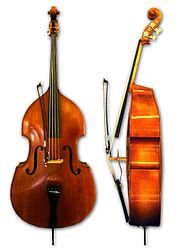Double bass

Side and front views of a modern double bass with a French-style bow
|
|
| String instrument | |
|---|---|
| Other names | Bass, string bass, upright bass, acoustic bass, acoustic string bass, contrabass, contrabass viol, bass viol, standup bass, bull fiddle and bass fiddle |
| Classification | String instrument (bowed or plucked) |
| Hornbostel–Sachs classification | 321.322-71 (Composite chordophone sounded by a bow) |
| Developed | 15th-19th century |
| Playing range | |
| Related instruments | |
| Musicians | |
The double bass or simply the bass (and numerous other names) is the largest and lowest-pitched bowed string instrument in the modern symphony orchestra. It is a transposing instrument and is typically notated one octave higher than sounding to avoid excessive ledger lines below the staff. The double bass is the only modern bowed string instrument that is tuned in fourths (like a viol), rather than fifths, with strings usually tuned to E1, A1, D2 and G2. The instrument's exact lineage is still a matter of some debate, with scholars divided on whether the bass is derived from the viol or the violin family.
The double bass is a standard member of the orchestra's string section, as well as the concert band, and is featured in concertos, solo and chamber music in Western classical music. The bass is used in a range of other genres, such as jazz, 1950s-style blues and rock and roll, rockabilly, psychobilly, traditional country music, bluegrass, tango and many types of folk music.
The double bass is played either with a bow (arco) or by plucking the strings (pizzicato). In orchestral repertoire and tango music, both arco and pizzicato are employed. In jazz, blues, and rockabilly, pizzicato is the norm. Classical music uses just the natural sound produced acoustically by the instrument; so does traditional bluegrass. In jazz, blues, and related genres, the bass is typically amplified with an amplifier and speaker.
...
Wikipedia

